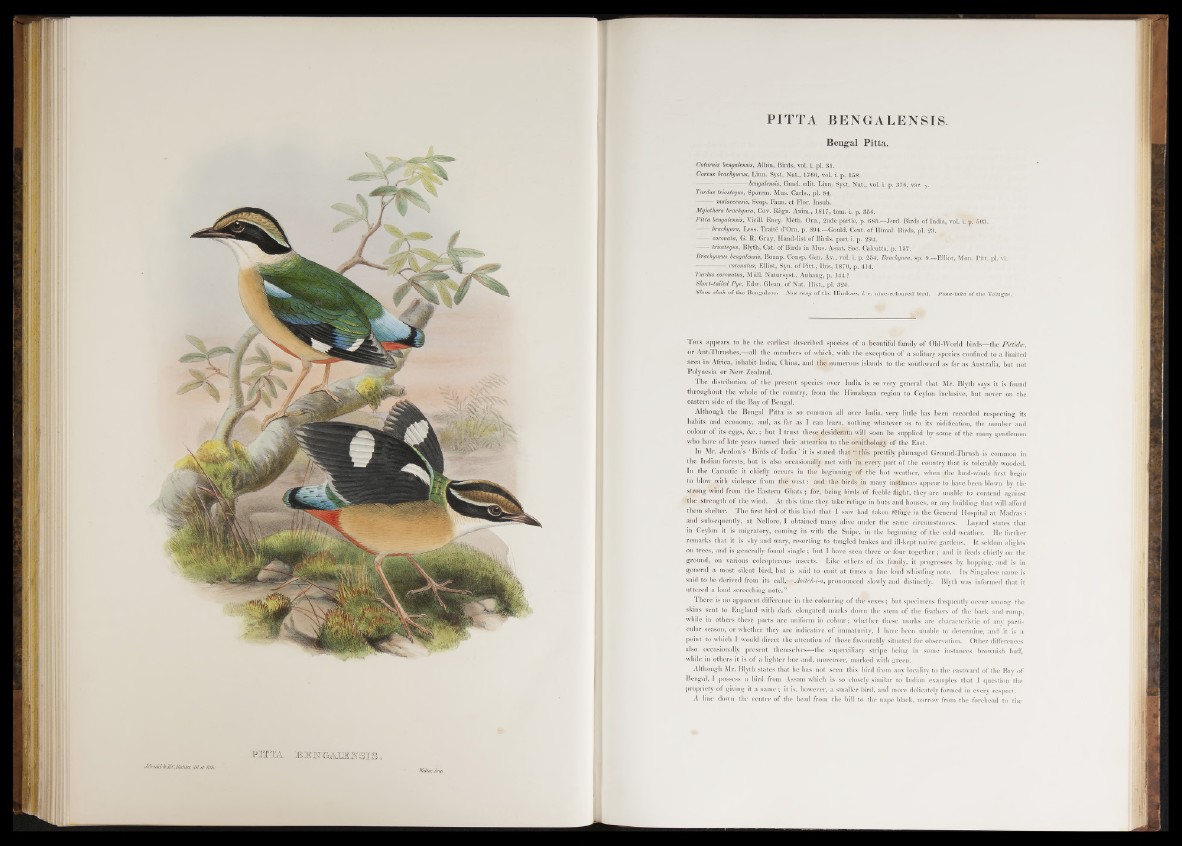
PITICA. JBEffGAEEjCTSIS.
J&oiìld'&'JLCJìièhJjT, dtleb Tith/.
PITTA BENGALENSIS.
Bengal P itta .
Cotumix bengalensis, Albin, Birds, vol. i. pi. 31.
Corms brachyurus, Linn. Syst. Na t., 1766, vol. i. p. 158.
— bengalensis, Gmel. edit. Linn. Syst. Na t., vol. i. p. 376, var. y.
Turdus triostegus, Sparrm. Mus. Carls., pi. 84.
malaccensis, Scop. Faun, e t Flor. Insub.
Myiothera brachyura, Cuv. Règn. Anim., 1817, tom. i. p. 356.
Pitta bengalensis, Vieill. Ency. Méth. Ora., 2nde partie, p. 685.—Jerd. Birds o f India, vol. i. p. 503.
— brachyura, Less. Traité d’O ra. p. 394.—Gould, Cent, o f Himal. Birds, pi 23.
coronata, G. R. Gray, Hand-list o f Birds, p a r t i. p. 294.
triostegus, Blytb, Cat. o f B irds in Mus. Asiat. Soc. Calcutta, p. 157.
Brachyurus bengalensis, Bonap. Consp. Gen. Av., vol. i. p; 254, Brachyura, sp. 9,-¿¿Elliot, Mon. P itt. pi. vi.
— coronatus, Elliot, Syn. of P itt., Ibis, 1870, p. 414.
Turdus coronatus, Miill. N a tu rsy s t, Anhang, p., 144 ?
Short-tailed Pye, Edw. Glean, of N a t. H ist., pi. 324.
Shum shah o f th e Bengalese. Non rung o f th e Hindoos, t. e. nine-coloured bird. Pona-inka of the Telugus.
T h is appears to be the earliest described species of a beautiful family o f Old-World birds—the Pittidte,
or Ant-Thrushes,—all the members of which, with the exception of a solitary species confined to a limited
area in-Africa, inhabit India, China, and the numerous islands to the southward as far as Australia, but not
Polynesia or New Zealand.
The distribution o f the present species over India is so very general that Mr. Blyth says it is found
throughout the whole o f the country, from the Himalayan region to Ceylon inclusive, but never on the
eastern side of the Bay of Bengal.
Although the Bengal Pitta is so common all over India, very little has been recorded respecting its
habits and economy, and, as far as I can learn, nothing whatever as to its nidification, the number and
colour of its eggs, &c. ; but I trust these desiderata will soon be supplied by some of the many gentlemen
who have o f late years turned their attention to tlW ornithology of the East.
In Mr. Jerdon s ‘ Birds of India it is stated that “ this prettily plumaged Ground-Thrush is common in
the Indian forests, but is also occasionally met with in every part of the country that is tolerably wooded.
In the Carnatic it chiefly occurs in the beginning of thè hot weather, when the land-winds first begin
to blow with violence from the^west: and the birds in many instances appear to have been blown by the
strong wind from the Eastern Ghats ; for, being birds of feeble flight, they are unable to contend against
fehe strength o f the wind. At this time they take refuge in huts and houses, or any building that will afford
them shelter. The first bird of this kind that I saw had taken rgfuge in the General Hospital at Madras ;
and subsequently, a t Nellore, I obtained many alive under the same circumstances. Layard states that
in Ceylon it is migratory, coming in with the Snipe, in the beginning of the cold weather. He further
remarks that it is shy and wary, resorting to tangled brakes and ill-kept native gardens. I t seldom alights
on trees, and is generally found single; but I have seen three or four together ; and it feeds chiefly on the
ground, on various coleopterous insects. Like others of its .family, it progresses by hopping, and is in
general a most silent bird, but is said to emit at times a fine loud whistliug note. Its Singalese name is
said to be derived from its call,—Aoitch-i-a, pronounced slowly and distinctly. Blyth was informed that it
uttered a loud screeching note.”
There is no apparent difference in the colouring of thè sexes ; but specimens frequently occur among the
skins sent to England with dark elongated marks down the stem of the feathers of the back and rump,
while in others these parts are uniform in colour; whether these marks are characteristic of any particular
season, or whether they are indicative of immaturity, I have been unable to determine, and it is a
point to which I would direct the attention of those favourably situated for observation. Other differences
also occasionally present themselves—the superciliary stripe being in some instances brownish buff,
while in others it is of a lighter hue and, moreover, marked with green.
Although Mr. Blyth states that he has not seen this bird from any locality to the eastward of the Bay of
Bengal, I possess a bird from Assam which is so closely similar to Indian examples that I question the
propriety o f giving it a name ; it is, however, a smaller bird, and more delicately formed in every respect.
A line down the centre of the head from the bill to the nape black, narrow from the forehead to the